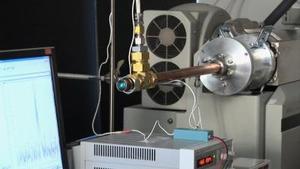Explosives detectionNew explosives vapor detection technology
Novel explosives detection method focuses on direct, real-time vapor detection rather than collection of explosives particles. It could change paradigm for explosives screening.

Detector senses traces as low as 25 parts per quadrillion // Source: pnnl.gov
A quick, accurate, and highly sensitive process reliably to detect minute traces of explosives on luggage, cargo, or travelling passengers has been demonstrated by scientists at the Department of Energy’s Pacific Northwest National Laboratory (PNNL). The vapor detection technology accurately detects and identifies the vapors of even very low-volatility explosives in real time at ambient temperature and without sample pre-concentration.
Details are outlined in a recent issue of Analytical Chemistry.
A PNNL release reports that rather than searching for particle residue using a typical method like surface swipes or using pulses of air to dislodge particles for analysis, the system “sniffs” directly for explosives vapors, much the way bomb-sniffing canines do.
“We have demonstrated direct, real-time vapor detection for the low-volatility explosive compound RDX, which is used in many types of explosives,” said David Atkinson, senior research scientist at PNNL. Low-volatility compounds are those which release very small amounts of the explosive vapor typically at parts per trillion levels or lower, making it extremely difficult to detect. The PNNL system easily detects vapors from a fingerprint-sized sample of RDX at levels below 25 parts per quadrillion.
“The system correctly identified the RDX vapor using selective atmospheric pressure chemical ionization with mass spectrometry,” explained Atkinson. The approach involves pulling an air sample stream and ionizing it within a reaction region in an atmospheric flow tube. The ionized sample moves to a mass spectrometer for ion detection and identification. These air samples need no heating or pre-concentrating. Analysis happens in about one second.
— Read more in Robert G. Ewing et al., “Direct Real-Time Detection of RDX Vapors Under Ambient Conditions,” Analytical Chemistry 85, no. 1 (7 December 2012): 389–97 (DOI: 10.1021/ac302828g)
